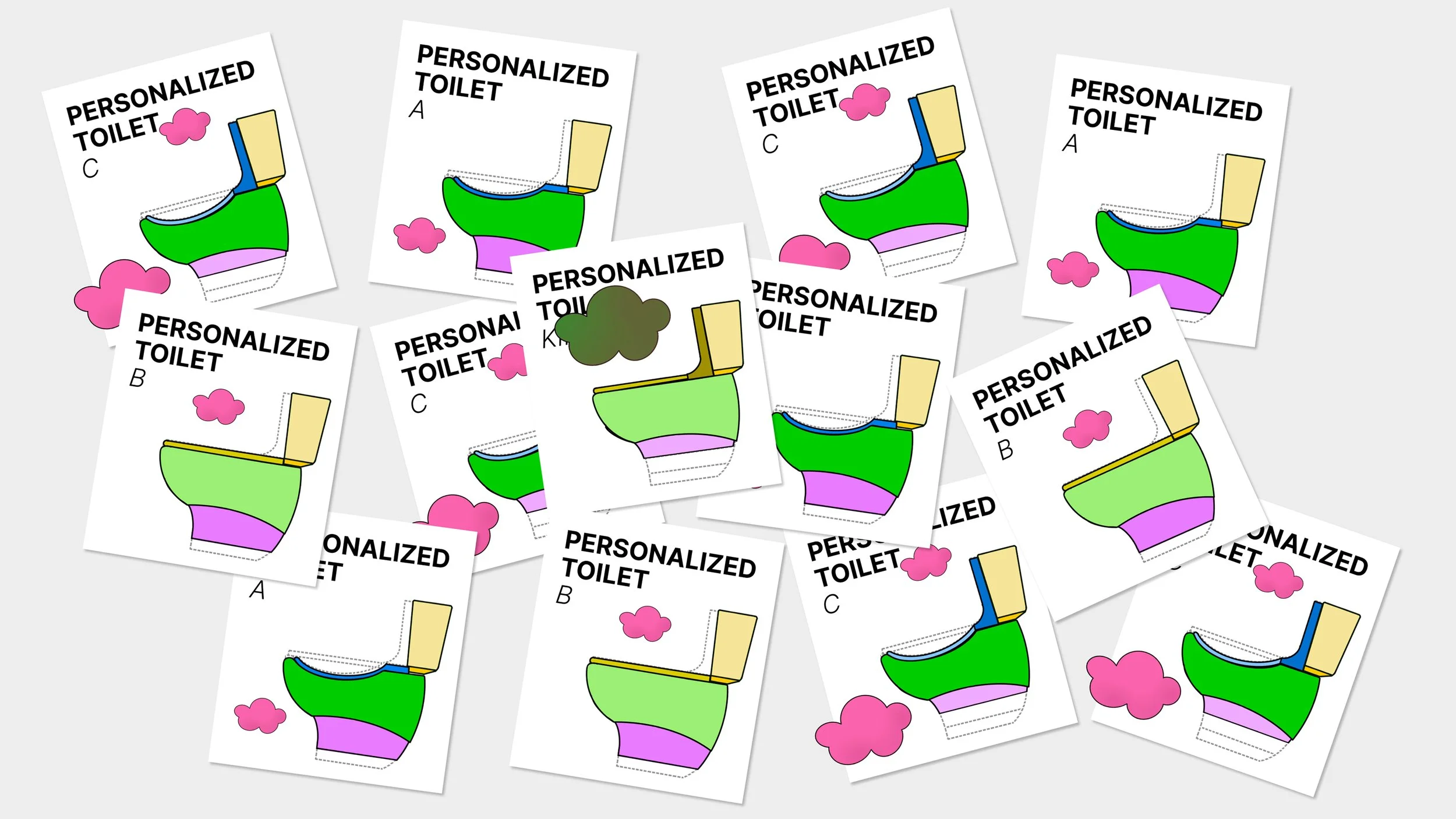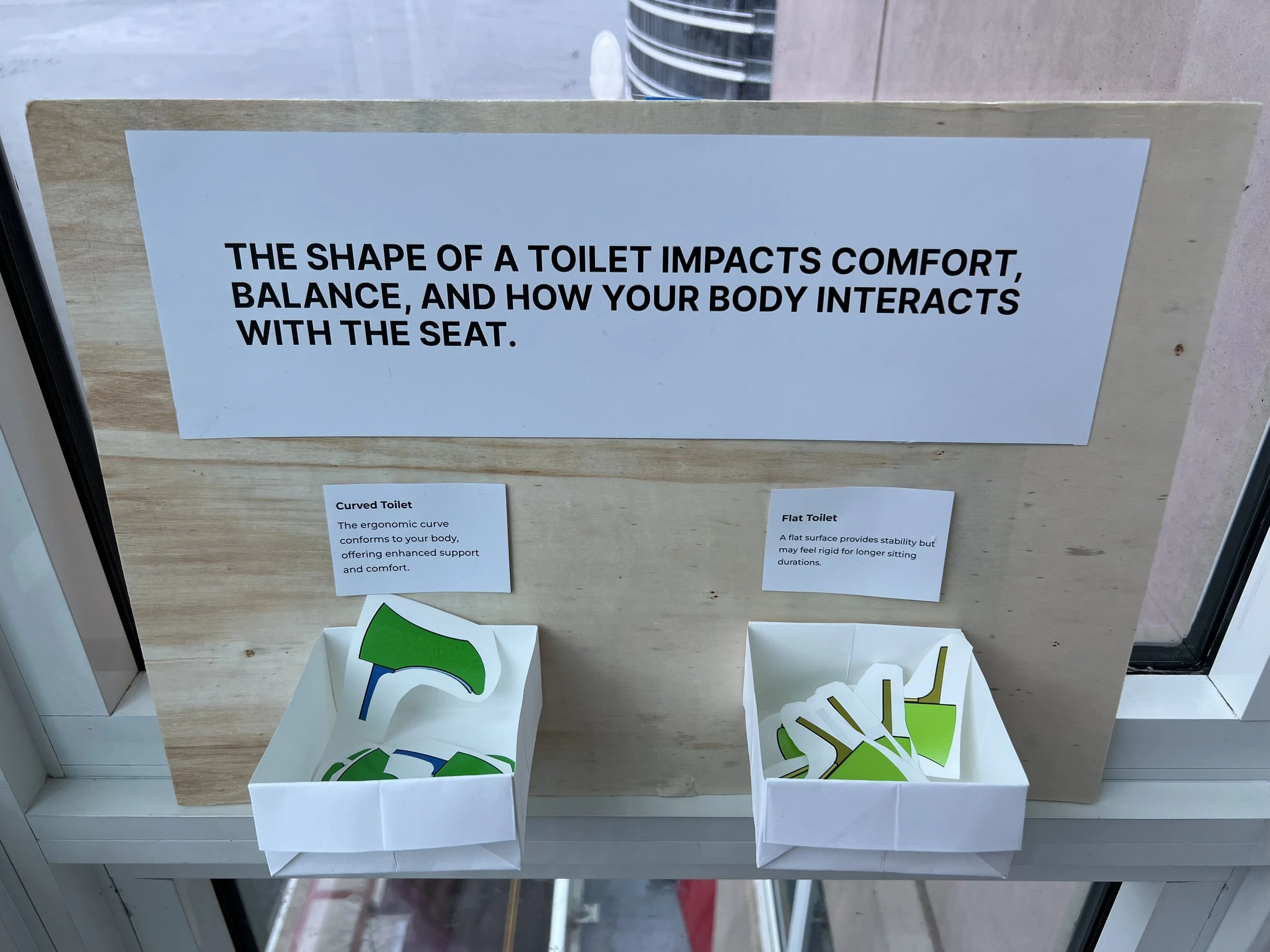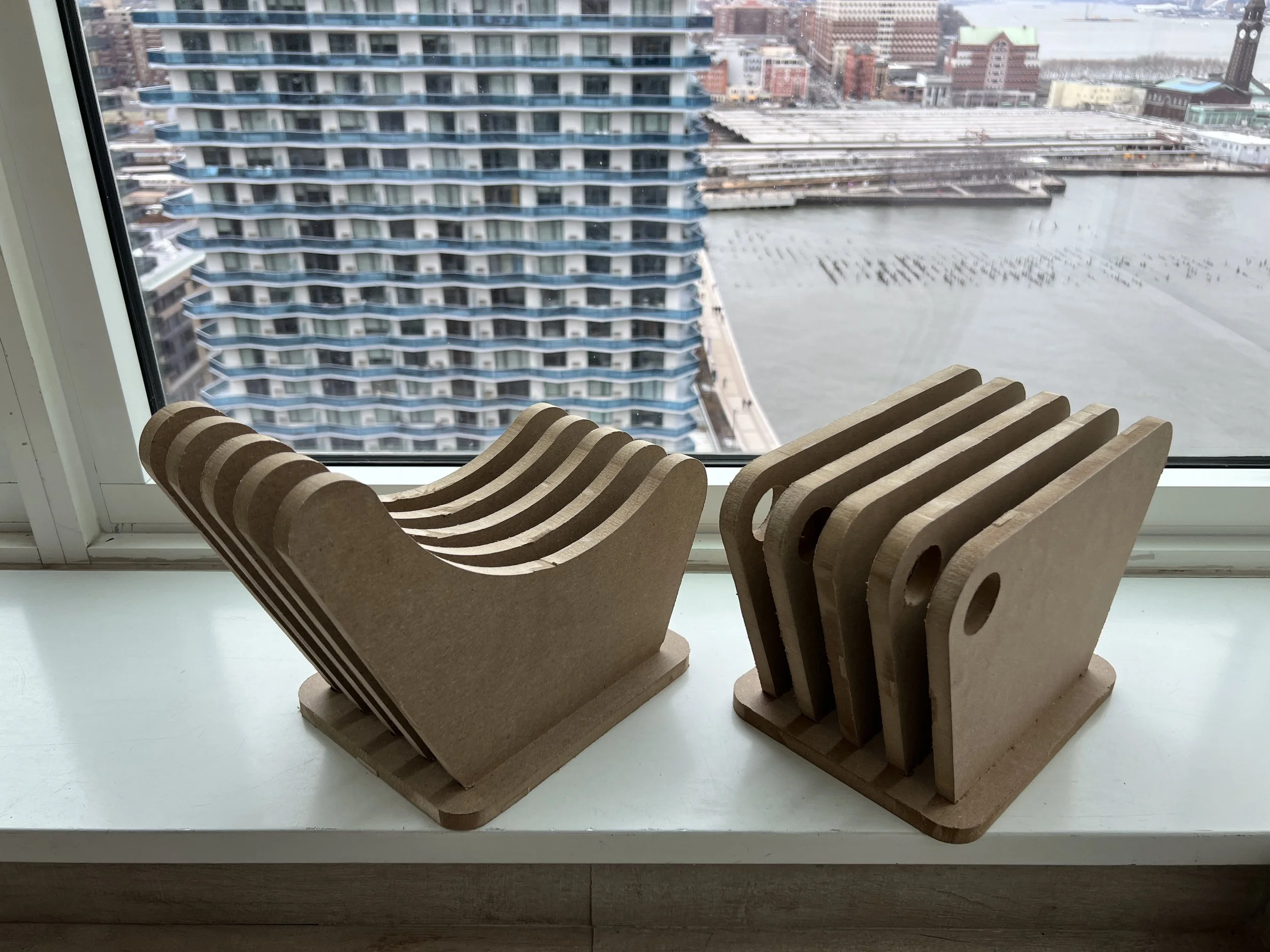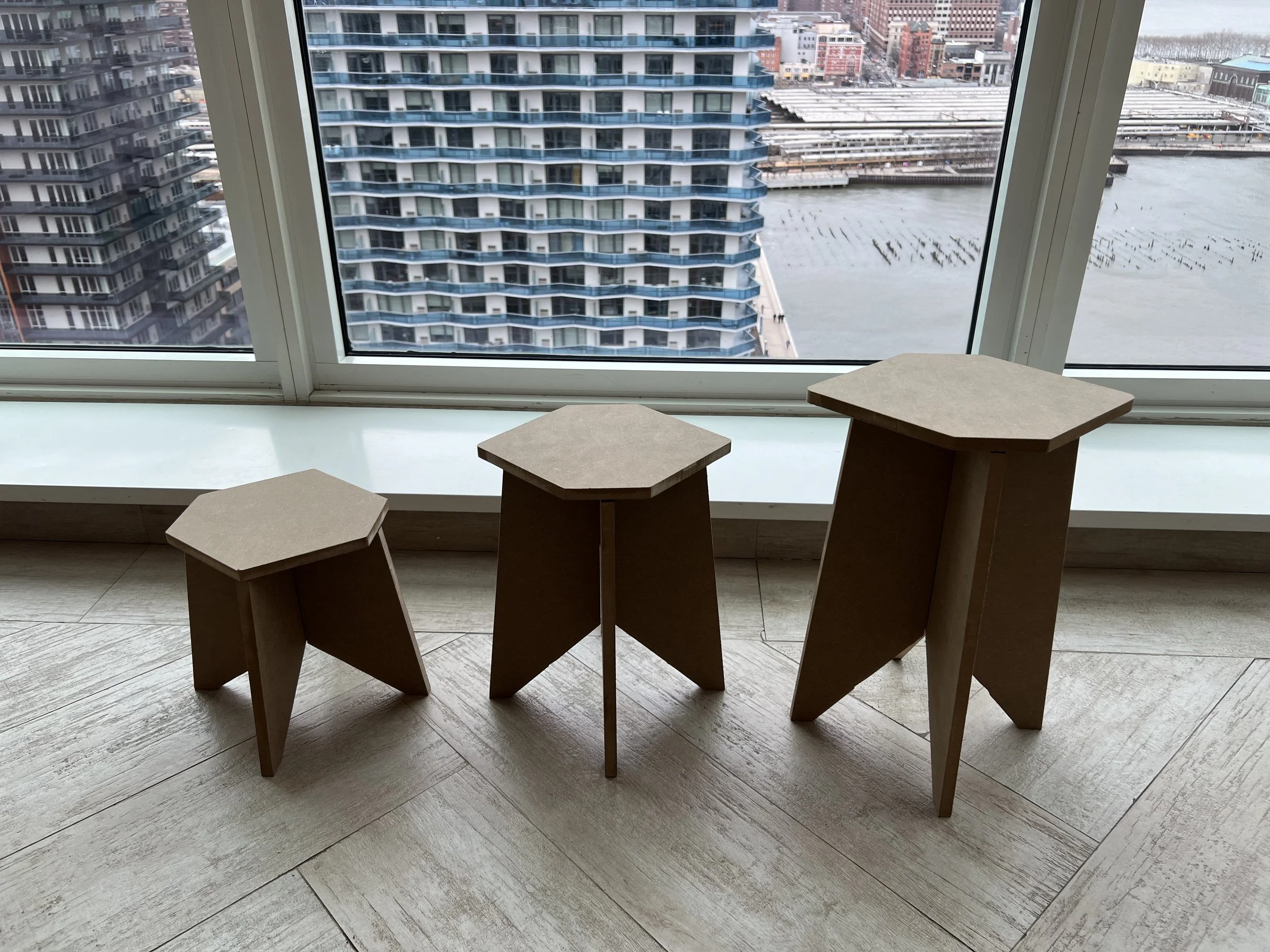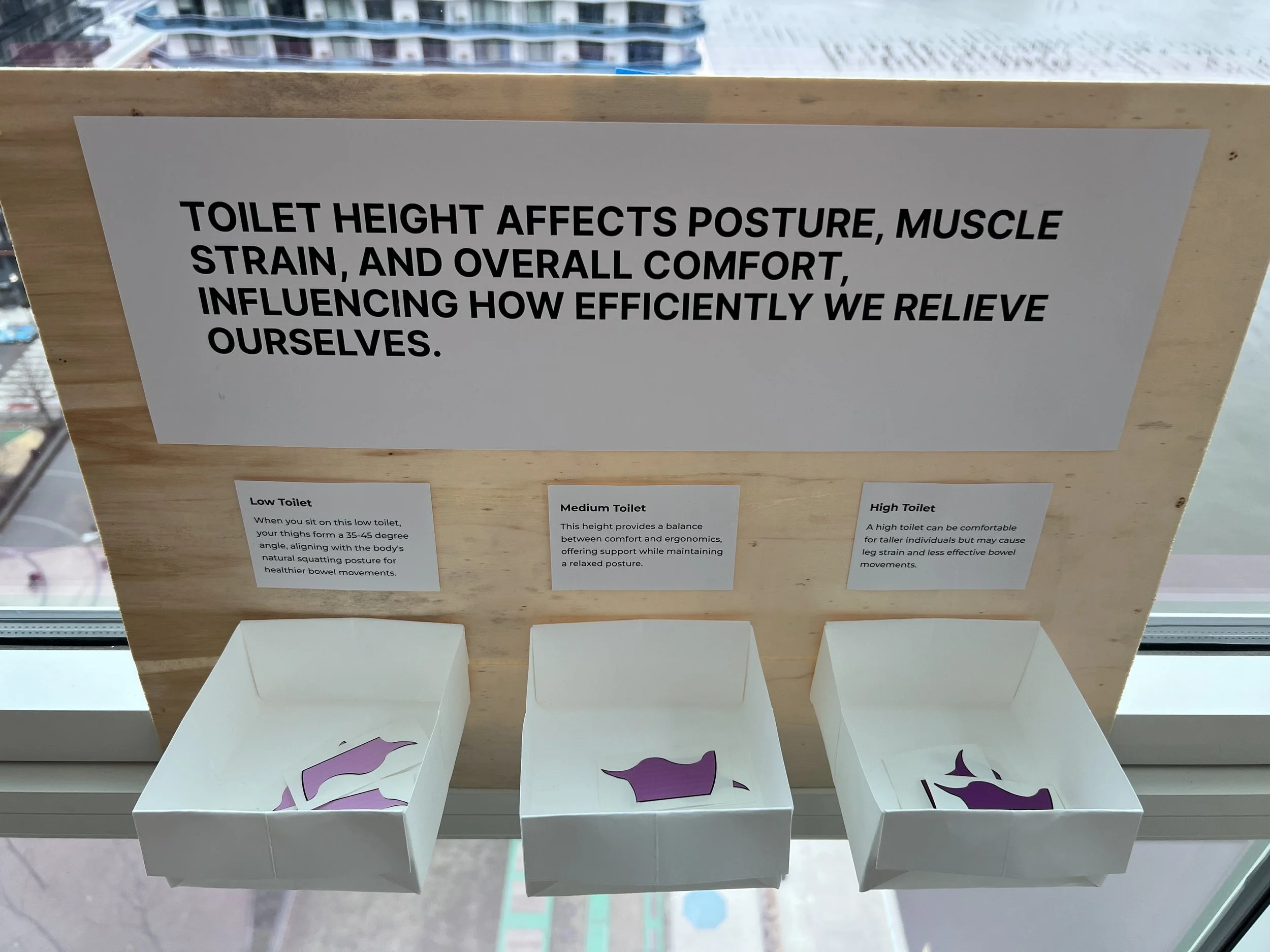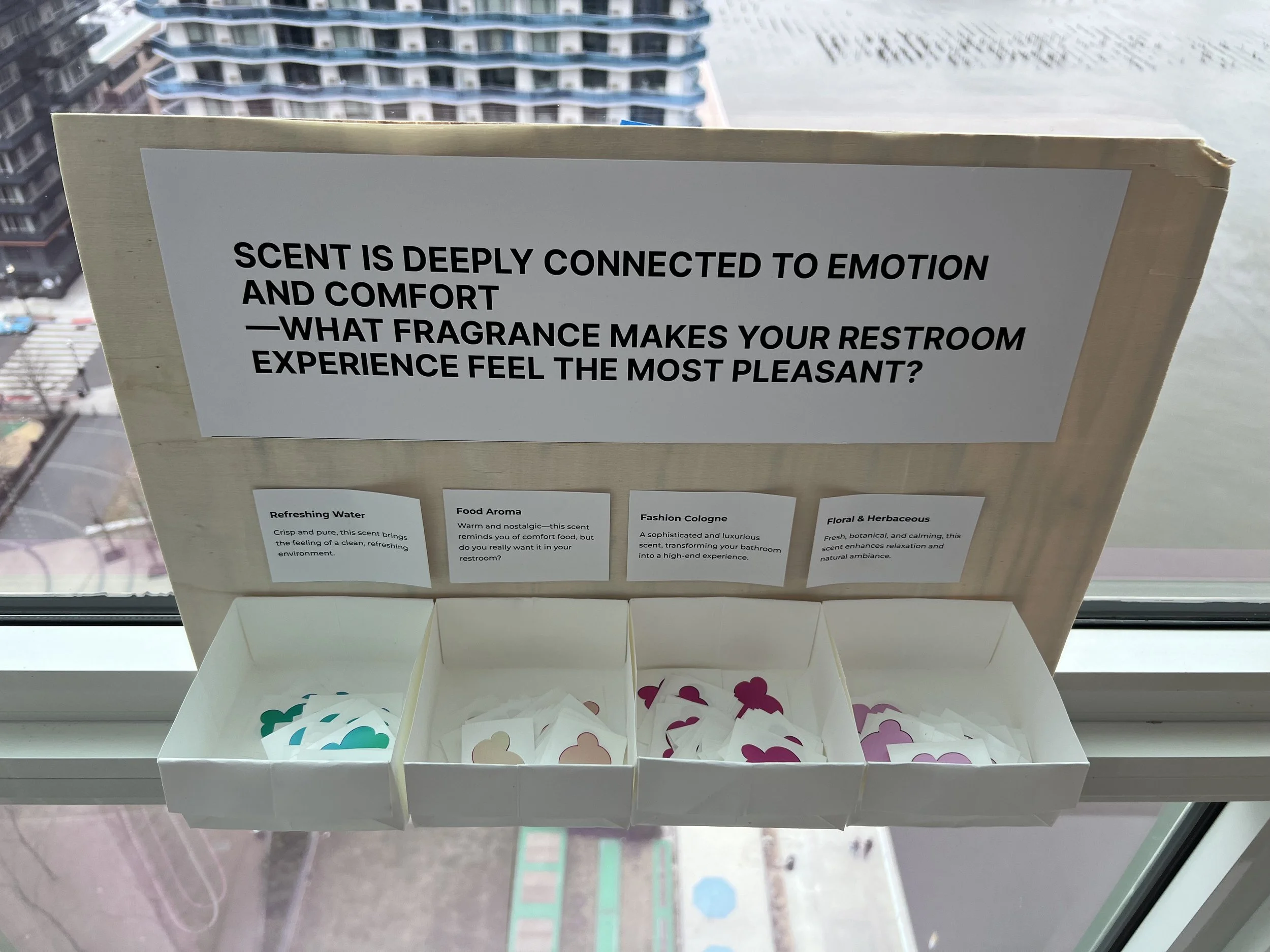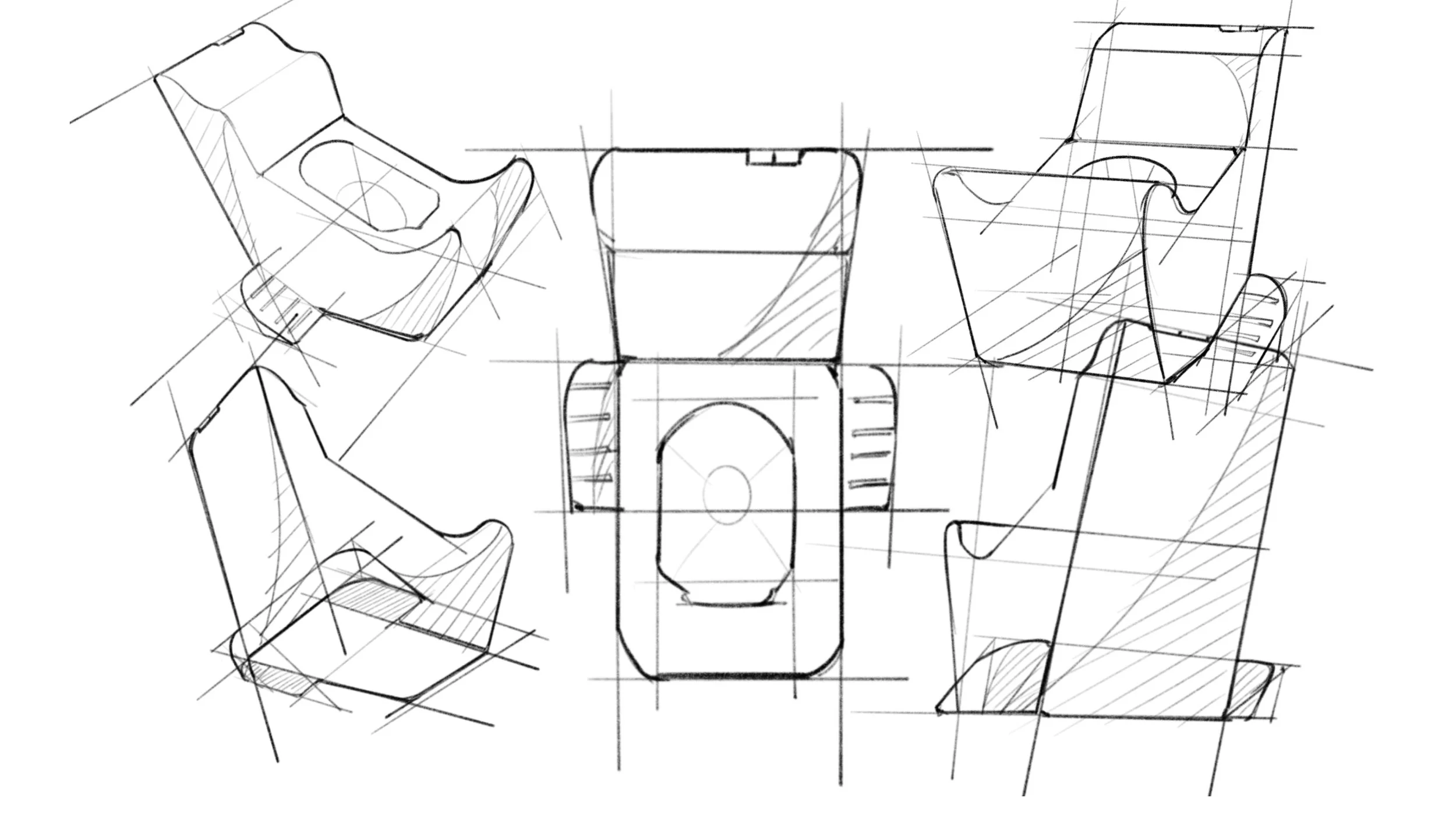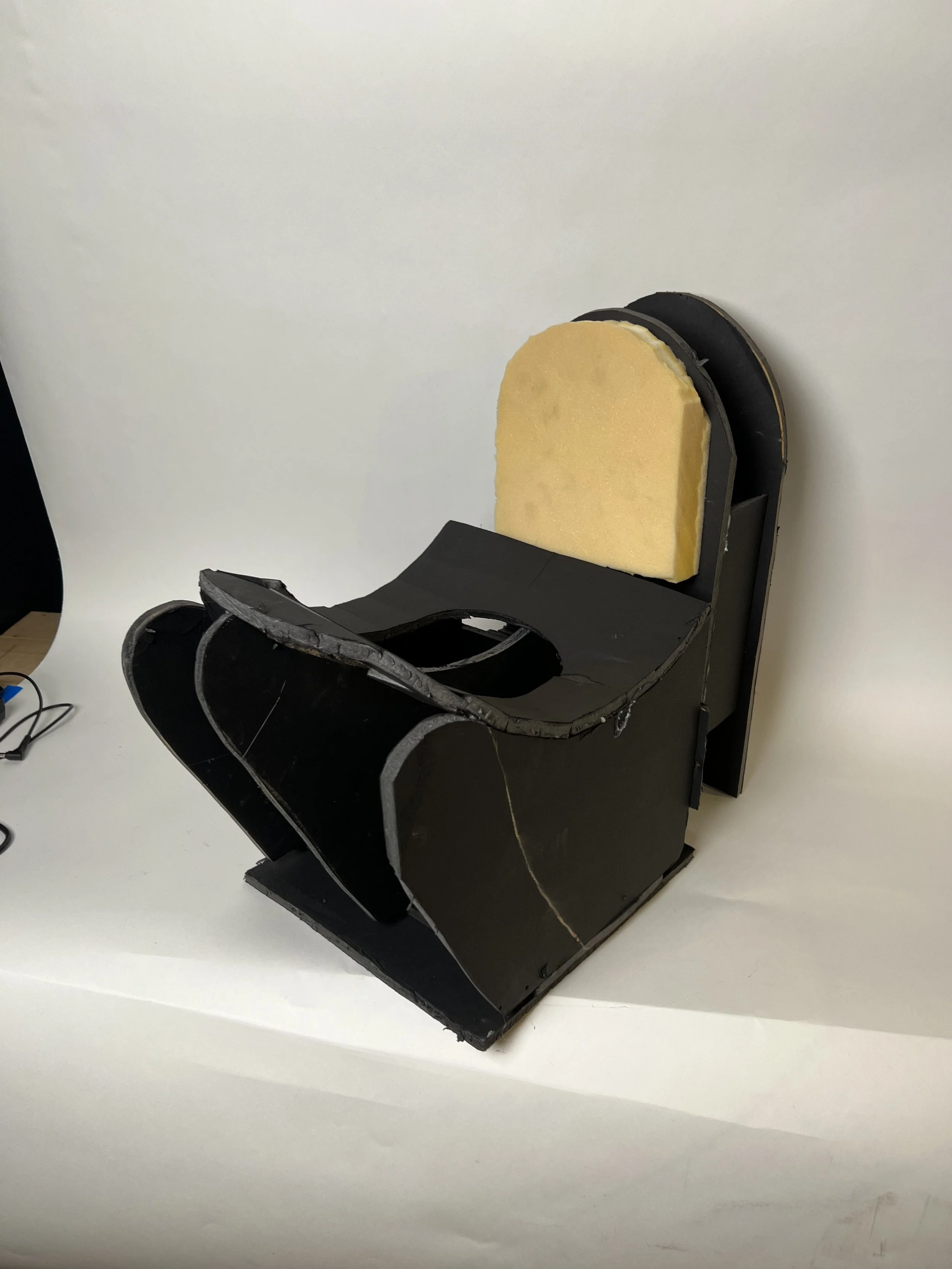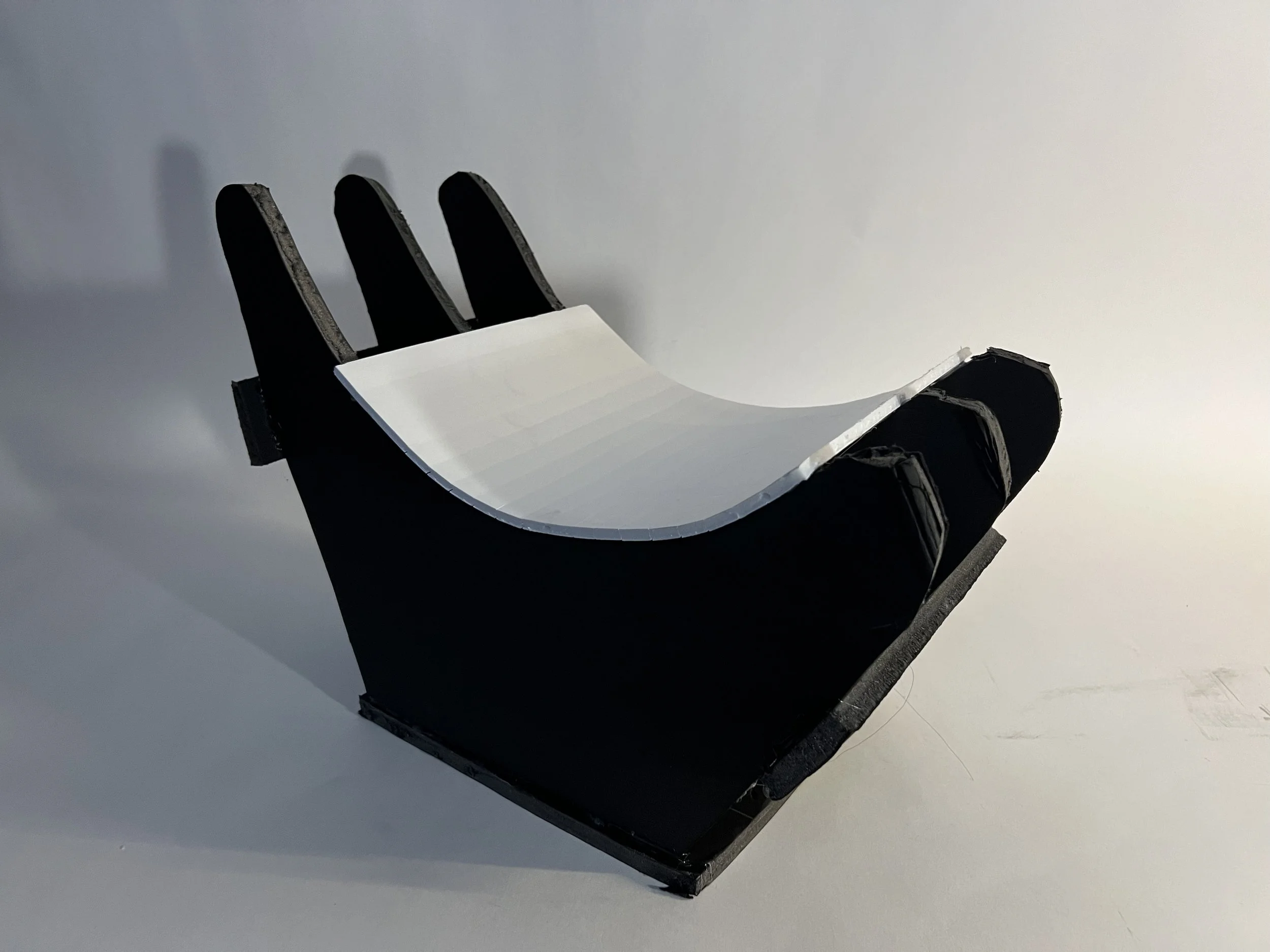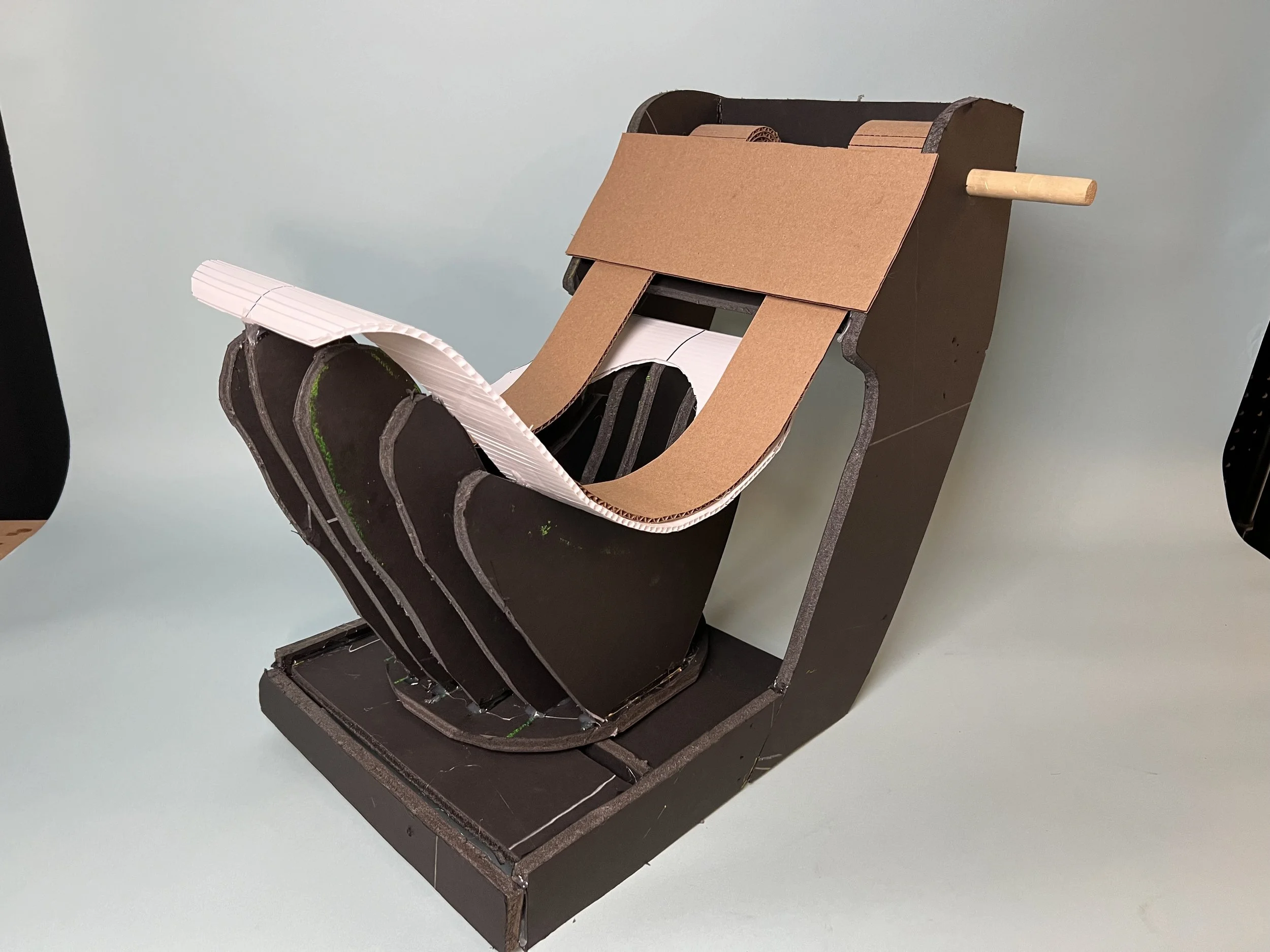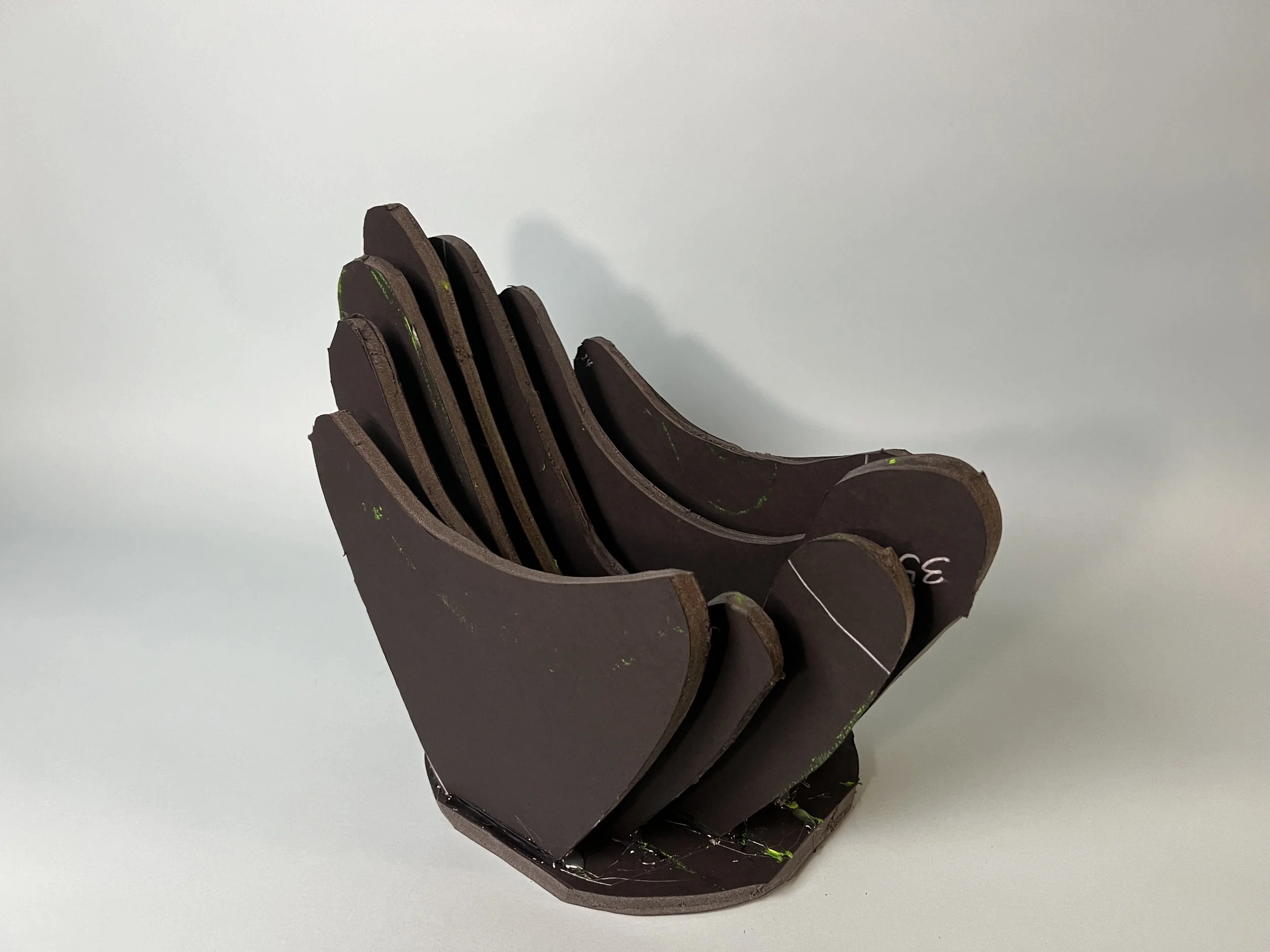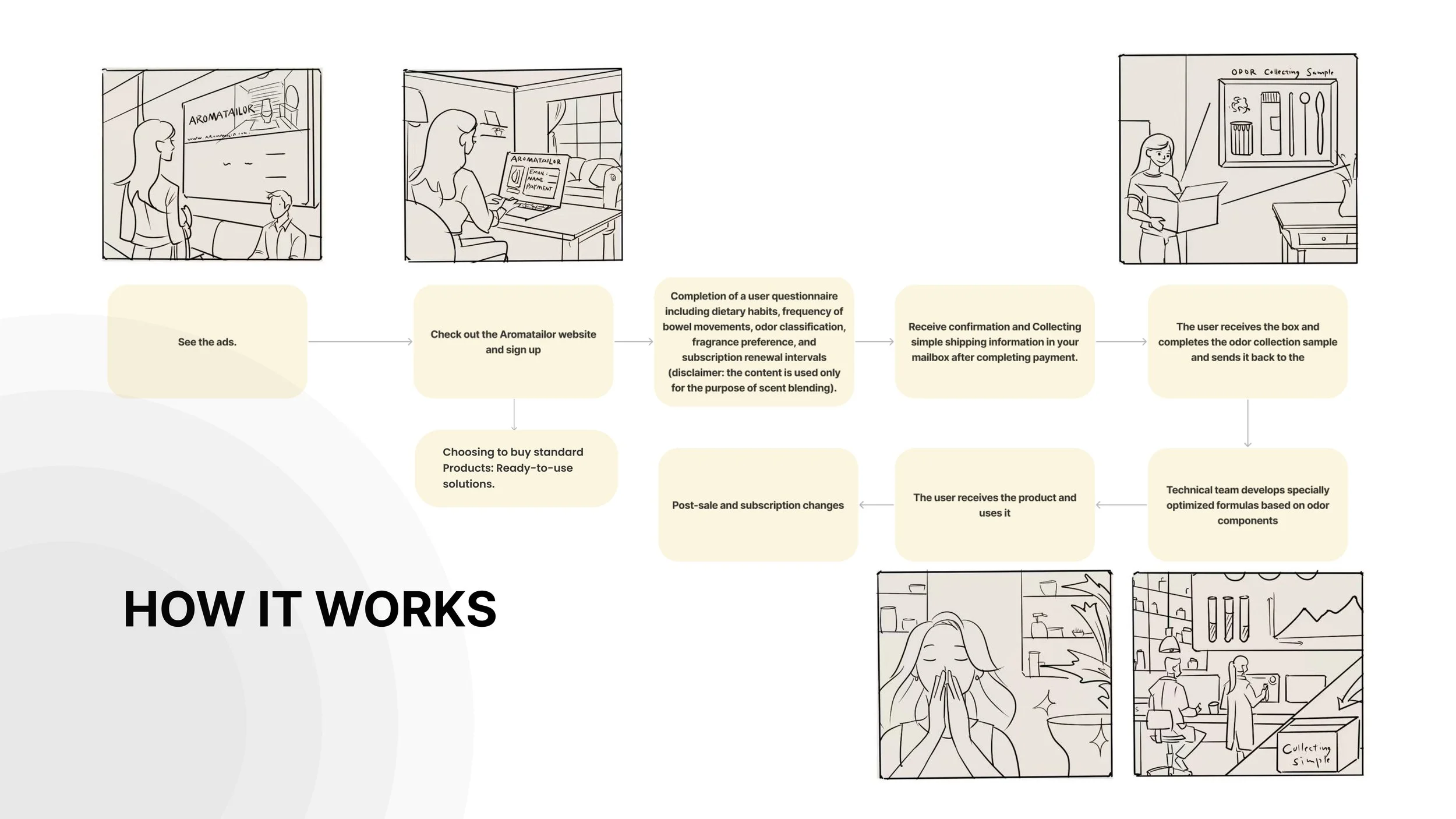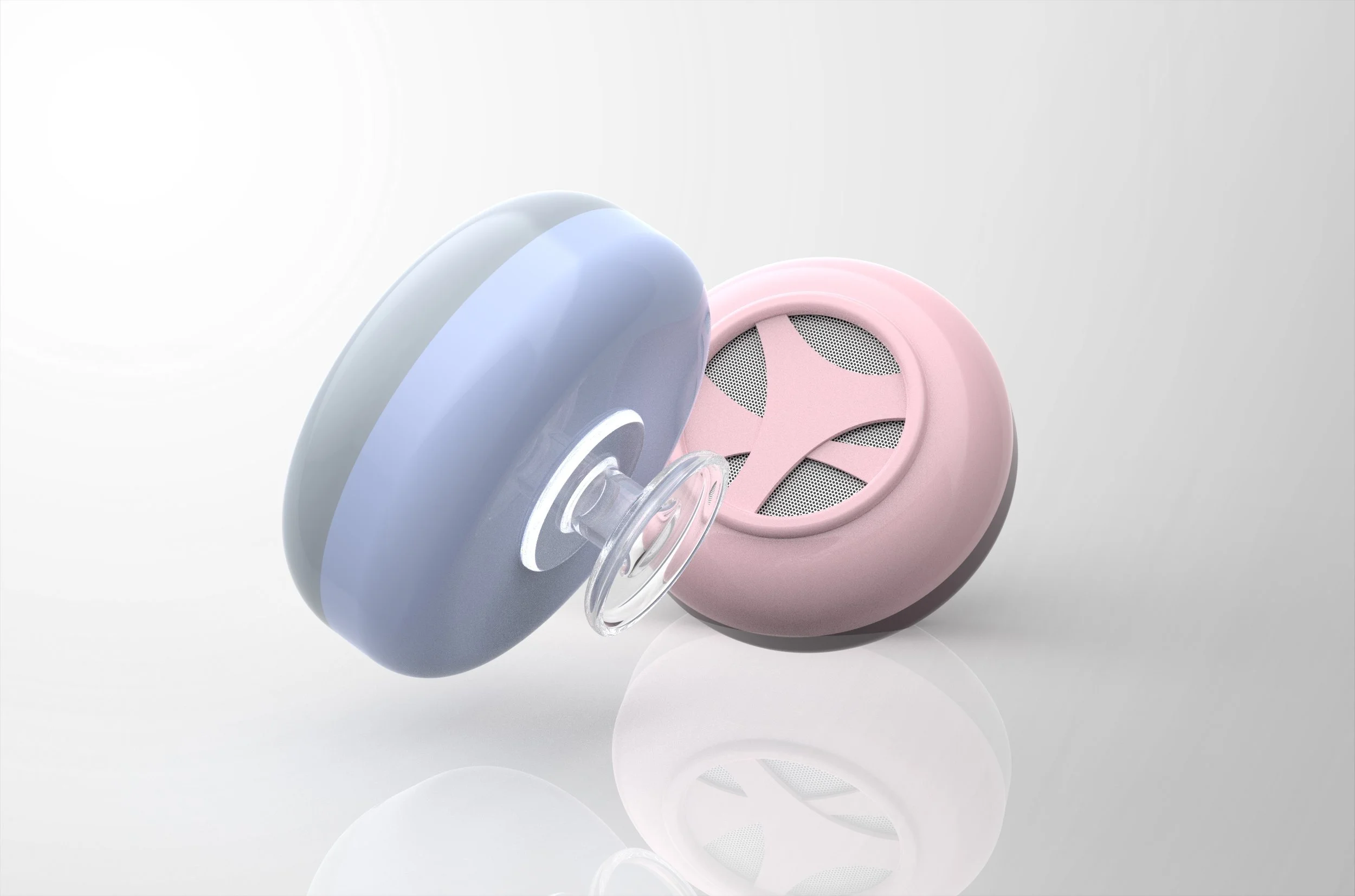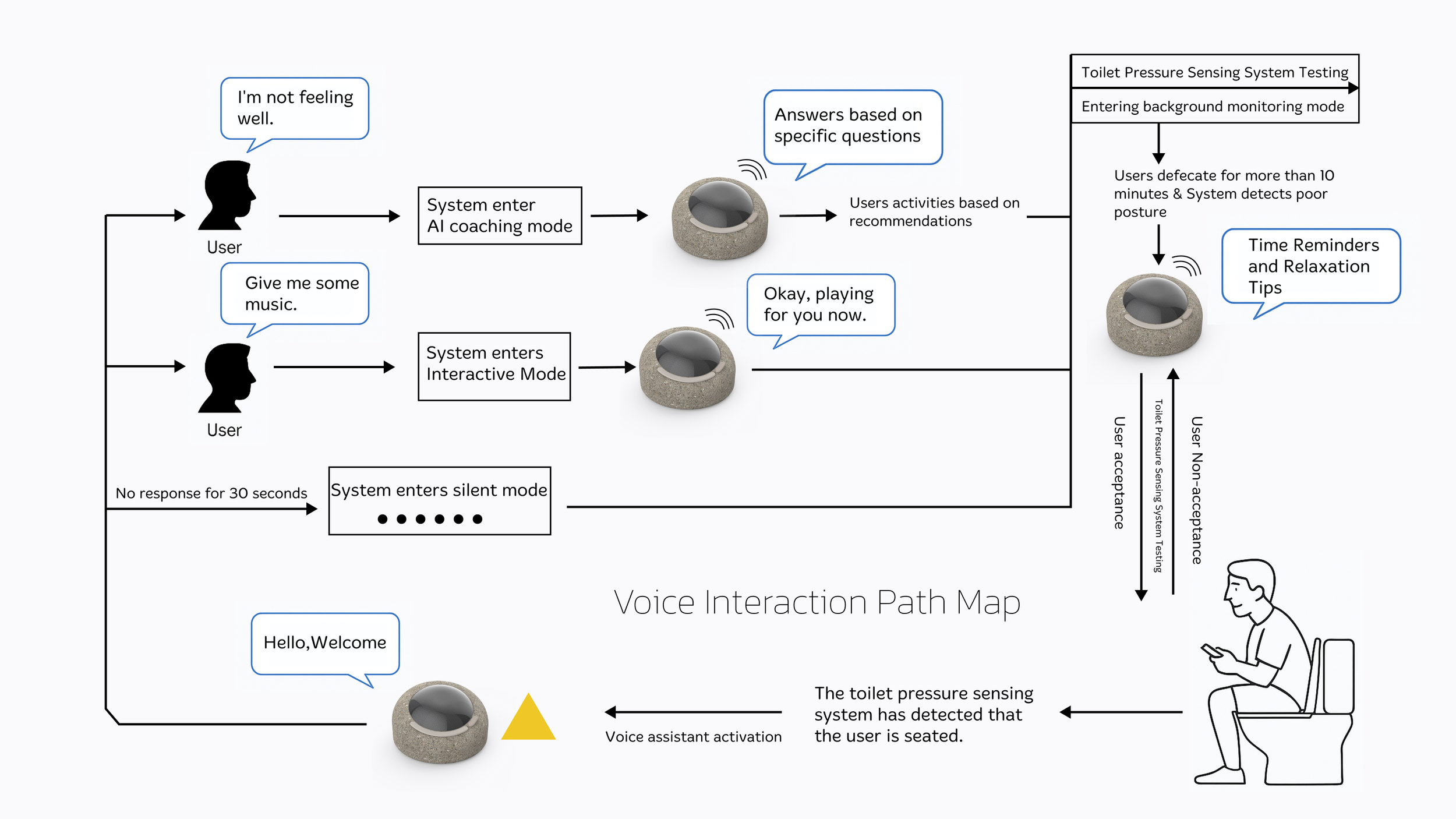Rethinking Toilets: Aligning Design with Human Needs
Zhiwen (Kira) Fu’s thesis, Rethinking Toilets: Aligning Design with Human Needs, asks a quietly radical question: what if the most frequently used object in our lives—the toilet—was never truly designed with our bodies in mind? When Kira found herself tiptoeing and searching for a stool to support her feet—constantly shifting posture on the toilet—she began to wonder: “Is this a personal problem, or is something fundamentally wrong?” The issue, she realized, could lie in human anatomy, unhealthy bowel habits, or perhaps a flaw in the design of the toilet itself.
““At its core, the modern toilet embodies a paradox.
Its sleek aesthetics and technological features mask a deeper issue:
its design neglects the body’s natural needs. ”
In a world increasingly filled with “smart” devices, few people stop to consider whether the toilet, a centuries-old design, actually supports healthy human anatomy and behavior. As a product designer, Kira didn’t set out to make toilets more high-tech. Instead, she sought to make them more meaningful—rethinking their form, function, and cultural context to better align with how our bodies naturally work. Traditionally, toilet design has prioritized plumbing efficiency and visual aesthetics—often at the expense of user comfort and well-being. The posture, emotional experience, and physical health of the people using them are rarely taken into account.
“An action as ordinary as going to the bathroom shouldn't cause this much discomfort.”



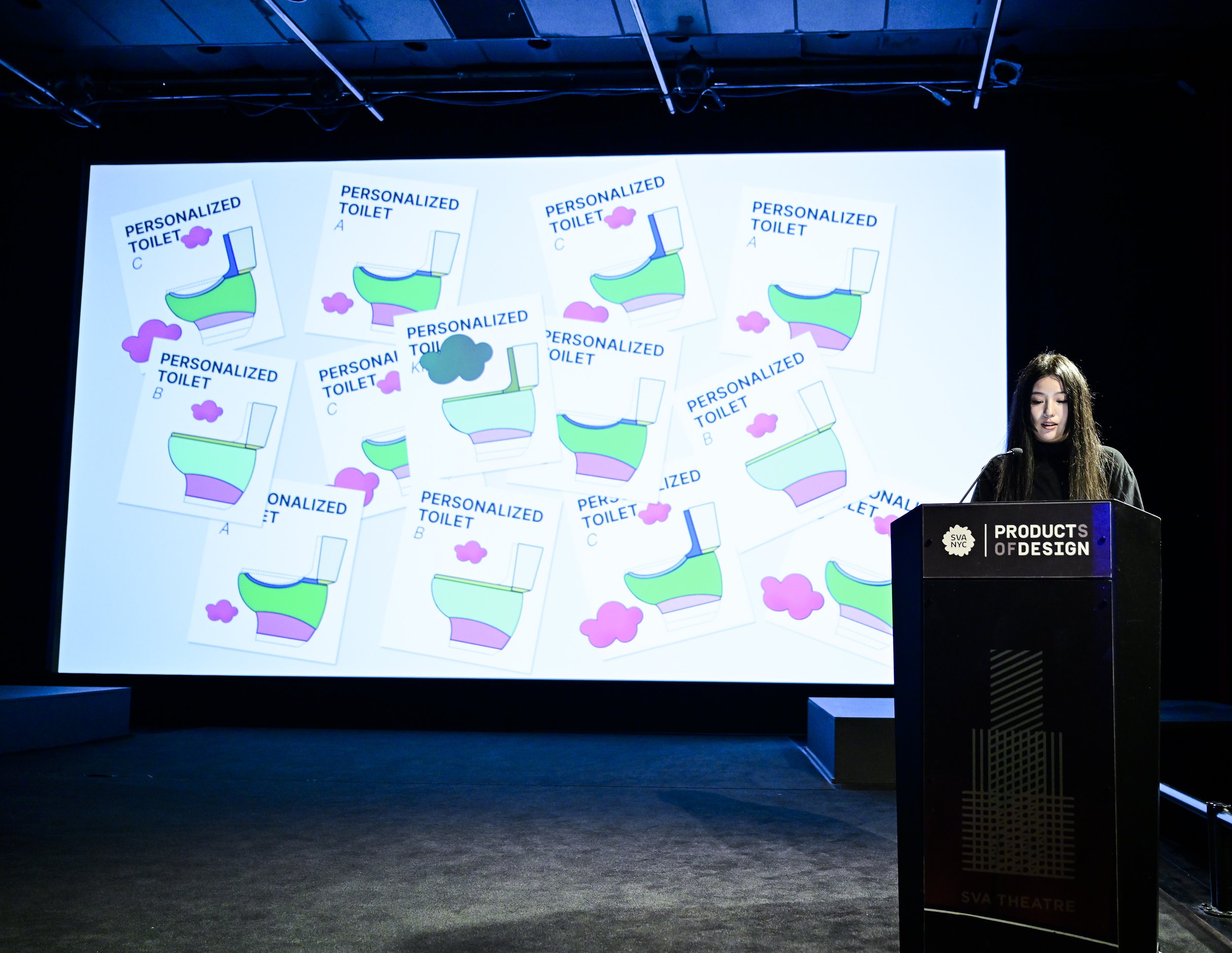
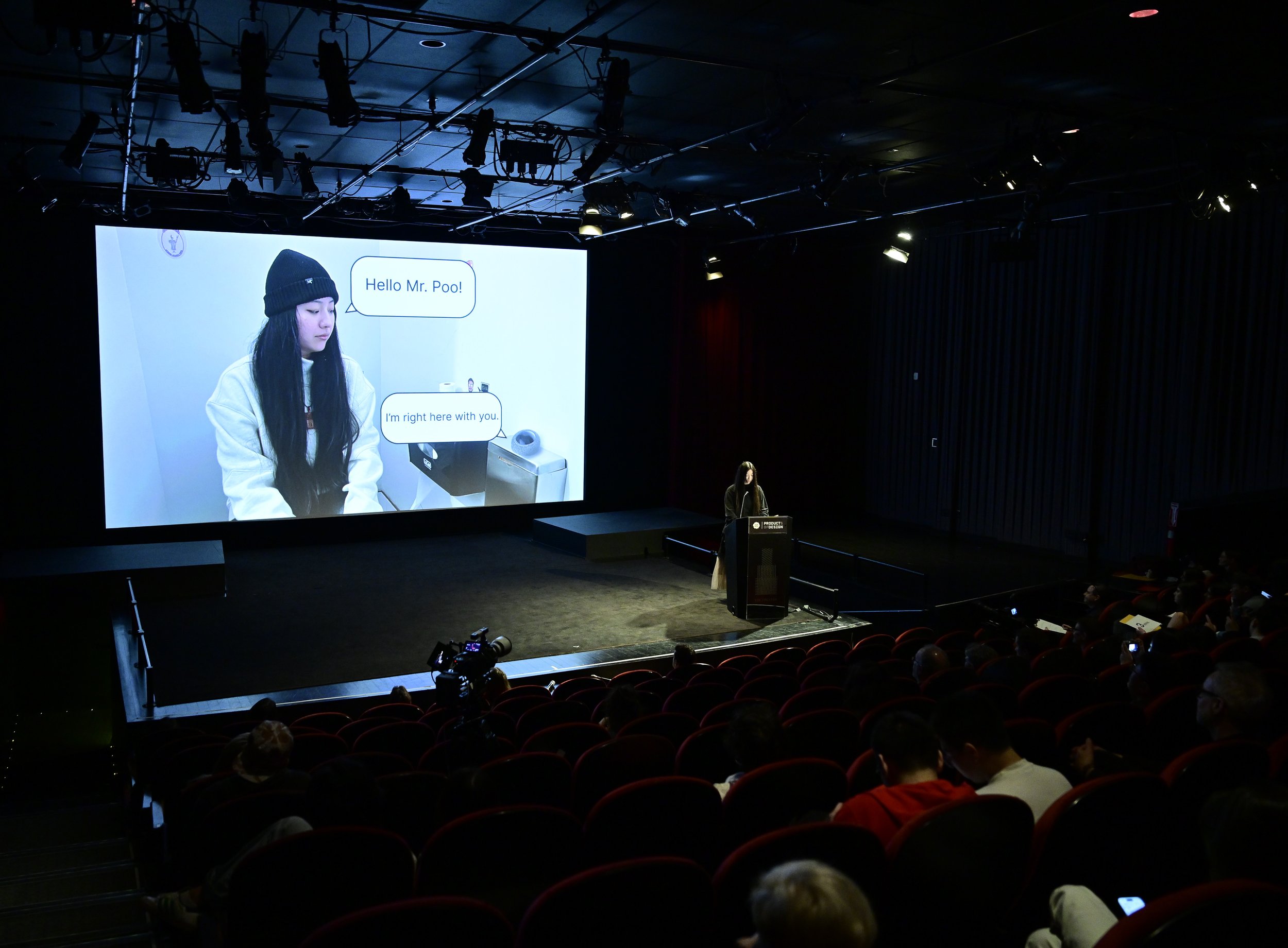
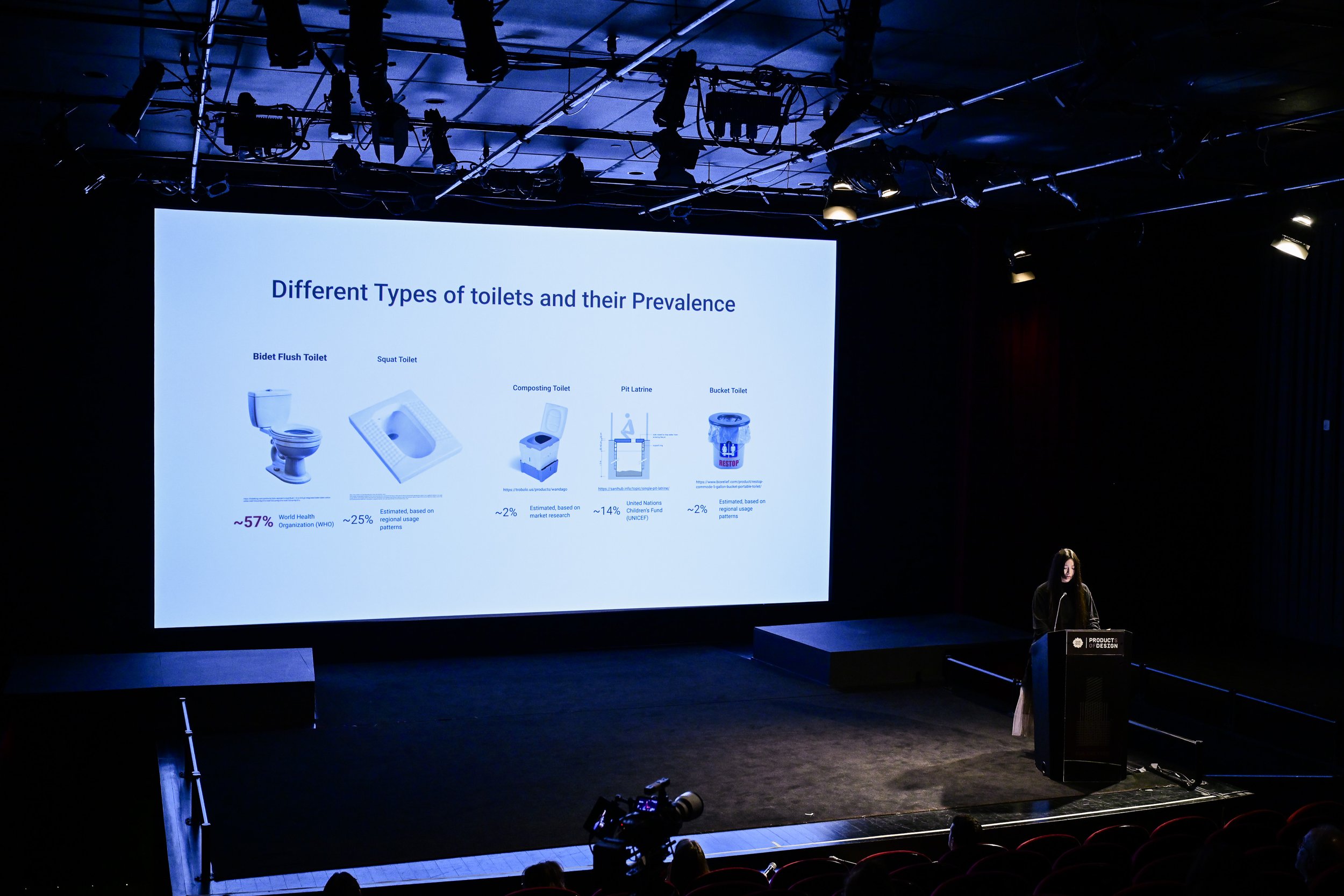
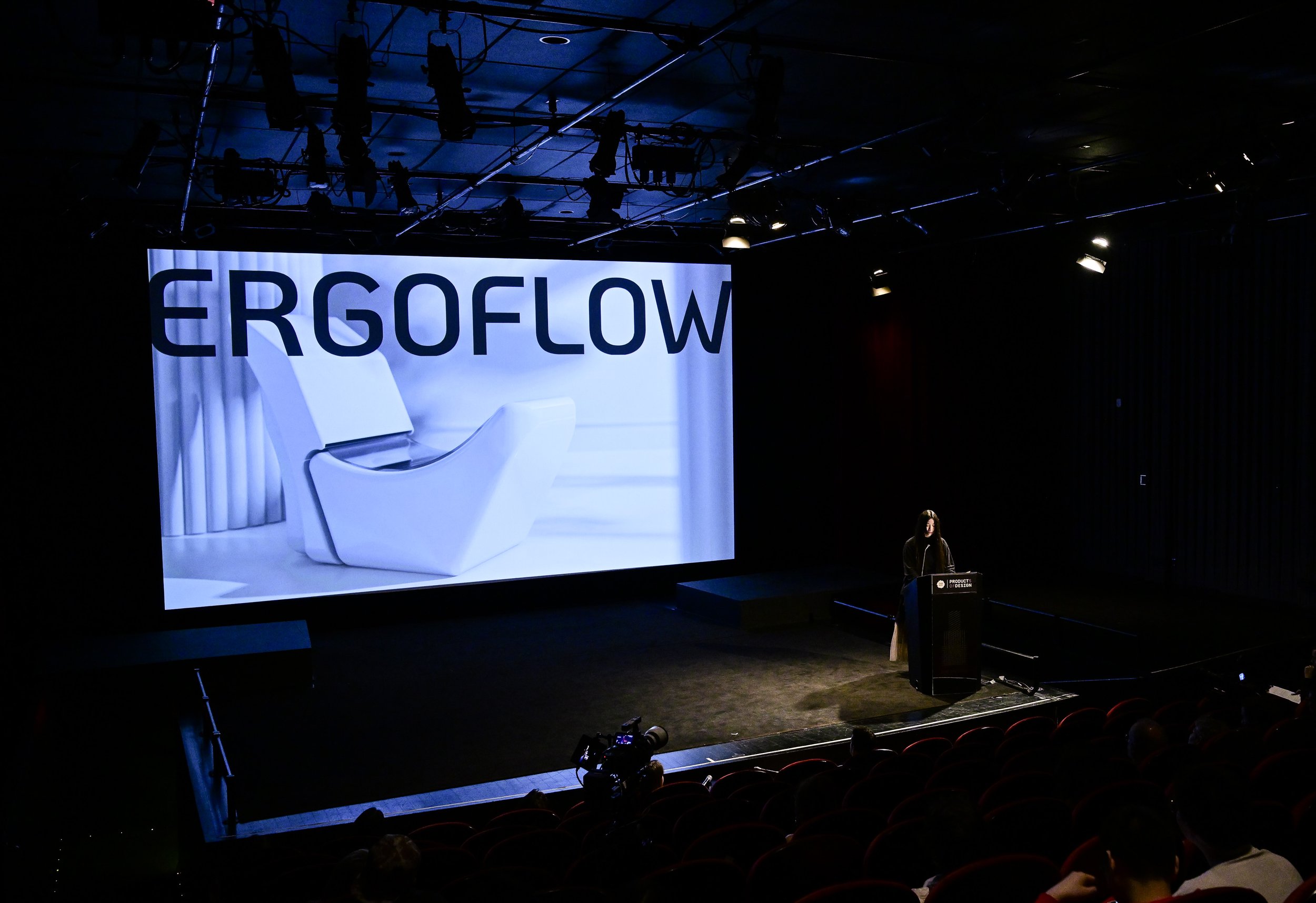
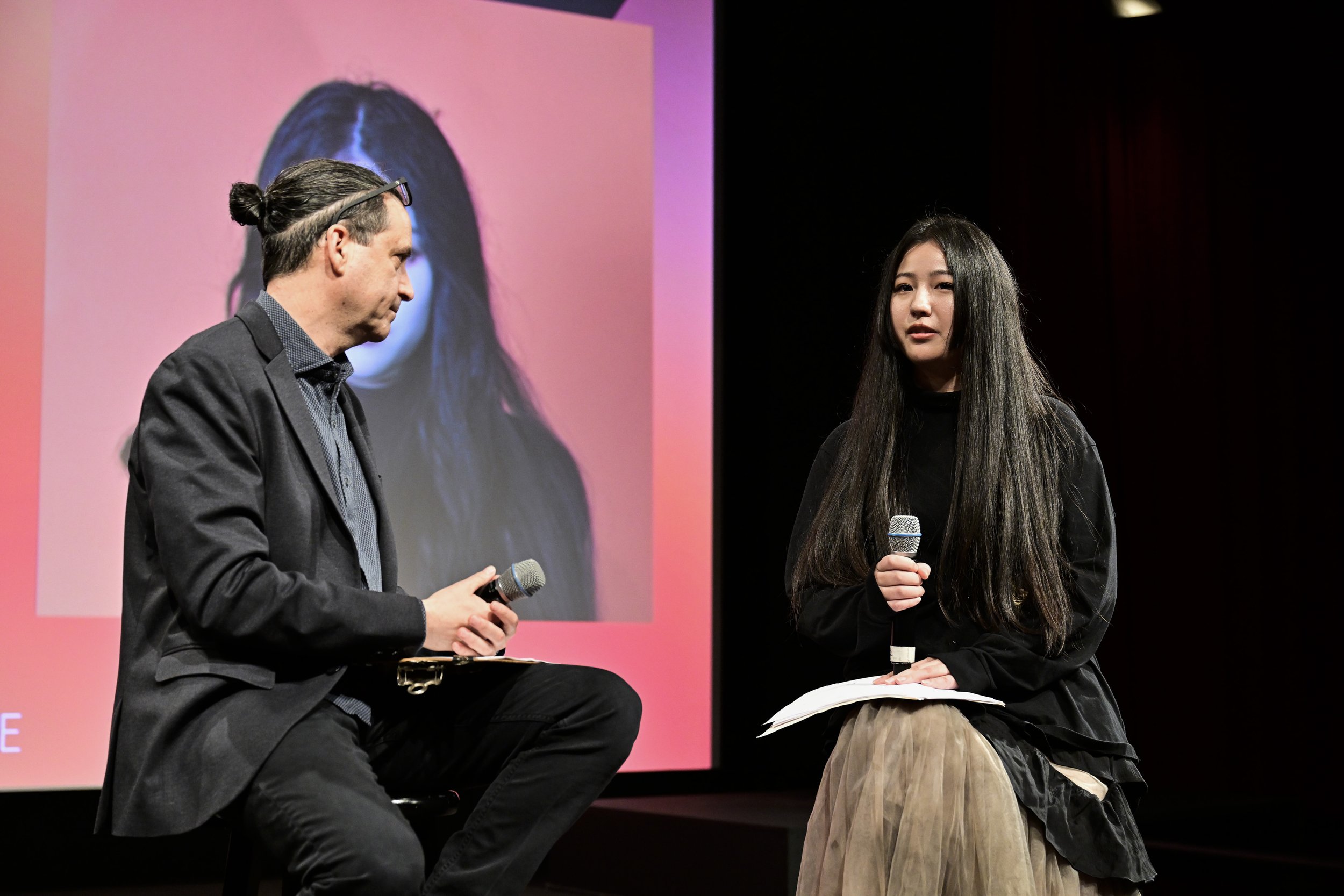

To better understand the disconnect, Kira conducted a comprehensive, multi-dimensional study—combining ergonomic analysis, behavioral observation, expert interviews, and a user survey with 46 participants. The findings were striking: only 23.9% of respondents described themselves as "very comfortable" on standard toilets. Nearly one-third reported frequent discomfort, and 56.5% said the height of the toilet felt unsuitable. Some respondents voiced deep frustration, with one remarking, “Constipation makes me want to cry.”
“These results made me realize,” Kira reflected, “an action as ordinary as going to the bathroom shouldn't cause this much discomfort.”
Workshop: Deep dive into pain points
In addition to surveys and interviews, Kira organized workshops to spark open conversations around people’s real-life toilet experiences. Participants shared a wide range of concerns—from physical discomfort to hygiene. Some recounted numb legs from sitting too long, while others cited difficulty exerting force when their feet didn’t touch the floor. Common refrains included: “My legs get numb after sitting too long,” “I can’t exert strength if my feet don’t touch the ground,” “I need a stool,” and “The restroom smells awful.” These personal accounts further underscored the misalignment between standard toilet design and human physiological and sensory needs.
Give a Shift: A Unique Exhibition
Kira’s first experimental intervention, titled Give a Shift, took place in the communal rooftop activity room of a residential building. The high-traffic, low-pressure setting made it an ideal place for casual reflection and spontaneous participation. The exhibition invited visitors into an immersive, multi-sensory space where toilet experiences could be explored openly—perhaps for the first time.
“It’s the first time I’ve ever talked about poop seriously—and I liked it!”
Inside the installation, participants interacted with toilet prototypes of varying heights and shapes, smelled different scent profiles, and used stickers to record their preferences at each station. At the end, they posted their sticker cards onto a communal wall, forming a collective “toilet preference map.” The format was playful yet revealing—transforming a once-taboo topic into something public, discussable, and even creatively engaging.
“It’s the first time I’ve ever talked about poop seriously—and I liked it,” said one visitor. For Kira, this kind of candid response was a turning point. “That comment strengthened my determination to address these real pain points,” she shared.
The data collected during the exhibition offered valuable insights:
71.4% of participants preferred curved toilet shapes, pointing to the comfort of more ergonomic forms.
42.9% selected medium-height (14-inch) toilets as their ideal, citing a balance between proper bowel positioning and ease of use.
In terms of olfactory experience, 52.4% favored “fresh aquatic” scents, suggesting a preference for clean, subtle, and natural-smelling environments.
Together, these findings inspired Kira to further explore how one of the most routine and overlooked aspects of daily life could be redesigned with empathy and intention.
From Data & Inspiration to Product: The Birth of Ergoflow
As Kira dove deeper into her research, one thing became clear: despite their daily use, toilets are rarely designed with the natural mechanics of the human body in mind. Cultural habits vary—squatting is common in many parts of Asia, while sitting toilets are dominant in Western countries—but the underlying physiology remains the same. Studies consistently show that squatting straightens the rectum by relaxing the puborectalis muscle, allowing for smoother and less strained bowel movements. In contrast, sitting toilets often require users to adopt a posture that bends the rectum, increases abdominal pressure, and contributes to conditions like constipation and hemorrhoids.
According to the Journal of Clinical Gastroenterology, achieving a 35-degree leg angle can reduce rectal pressure by nearly 30% and shorten bowel movement time by up to 70%. In 2014, the World Health Organization reported that around 12% of the global population suffers from constipation—often exacerbated by poor toilet posture.
With these insights in mind, Kira set out to create a toilet that prioritizes human anatomy, cultural nuance, and daily comfort. She began by sketching ideas and building basic cardboard models to test angles, posture, and user interaction.
The result is Ergoflow—a toilet designed to support a fixed forward-leaning position and calibrated to a height of 14 inches, achieving a leg-to-torso angle of 35–45 degrees. This angle, backed by medical research, minimizes rectal strain and encourages healthier bowel movements. But angle alone wasn’t enough. To accommodate diverse global habits, Ergoflow includes horizontal leg support structures. These elements offer stability for users accustomed to squatting and a sense of anchoring for sitting users—ensuring both can find a comfortable and intuitive posture.
Attention to comfort shaped every detail. A gently curved seat reduces tailbone pressure while subtly guiding the user into a natural forward lean. Meanwhile, hygiene and usability were also top priorities. An automatic lid mechanism ensures that once the user stands and flushes, the lid closes slowly—initiating a quiet and clean post-use cycle.
When testing the prototype, one participant exclaimed: “This is my savior! I hope you really produce it.” For Kira, that moment underscored the core belief behind Ergoflow: that truly effective design begins not with the object, but with the lived experience of the person using it.
AromaTailor: Personalizing Toilet Scents
During her research, Kira realized scent is a critical yet often overlooked psychological aspect of toilet experiences. "I guarantee no one enjoys smelling someone else's poop," said one interviewee. Thus, Kira desired AromaTailor, a personalized scent customization service that enhances restroom comfort.
Users complete a questionnaire about scent preferences and dietary habits, then receive a scent collection kit to gather personal samples. AromaTailor analyzes these results to create personalized solid fragrances, delivered directly to users. The product's suction-back allows versatile, space-efficient placement on any smooth surface, providing a significant advantage over traditional air fresheners.
Users complete a questionnaire about scent preferences and dietary habits, then receive a scent collection kit to gather personal samples. AromaTailor analyzes these results to create personalized solid fragrances, delivered directly to users. The product's suction-back allows versatile, space-efficient placement on any smooth surface, providing a significant advantage over traditional air fresheners.
AromaTailor uniquely combines personalized service with scent science, precisely matching user dietary habits and scent preferences to neutralize odors at their source. Continuous subscription updates ensure optimal scent performance, realizing a refined lifestyle concept: "fragrance designed exclusively for you."
Mr. Poo: Cultivating Healthier Habits
Changing environments and products is straightforward, but changing user habits—particularly around intimate issues like bowel movements—is challenging. Most people recognize poor habits but find it difficult to correct behaviors privately. This inspired Mr. Poo, a voice assistant designed specifically for toilets.
Mr. Poo adopts a screen-free, voice-only interaction design. It provides real-time guidance on how to adjust posture, reminds users to relax, and offers simple and accessible health advice. The logic behind this interaction approach lies in leveraging the natural, low-cognitive-load advantages of voice communication, avoiding the extended toilet time often caused by screen use. Through immediate feedback and continuous health prompts, Mr. Poo gradually helps users build better defecation habits.
User testing has shown that this interactive approach is engaging, significantly reduces toilet-related anxiety, and makes users more willing to accept and sustain behavioral improvements. Using pressure sensors in the seat, Mr. Poo detects user presence, initiating gentle voice prompts for correct posture and relaxation techniques.
If poor posture or prolonged use (over 10 minutes) is detected, Mr. Poo provides timely reminders, such as: "Lean forward slightly and elevate your knees for smoother relief." "If you're tense, try deep breathing—relax your abdomen."
If users don't respond within 30 seconds, the system automatically silences itself. Users can proactively interact by saying: "Mr. Poo," "Play calming music," or "I'm uncomfortable." Upon completion, the assistant encourages positively: "Great job today, remember to stay hydrated!" before returning to standby. This intuitive, unobtrusive system respects privacy while promoting healthier habits.
The toilet is one of humanity's most authentic spaces, deserving proper attention. Through design, Kira aims to reconnect bodies and products. Whether through interactive exhibitions, ergonomic design, scent customization, or voice interaction, every design decision in Kira’s project centered around human needs. Through this series of explorations, what she aimed to present was not merely a product or service, but a design philosophy grounded in deeper reflection: that truly good design must always be human-centered.
For a deeper look into Kira’s thesis process, research, and reflections, visit:
Thesis Repository on Notion – a comprehensive archive of Kira’s thesis development



